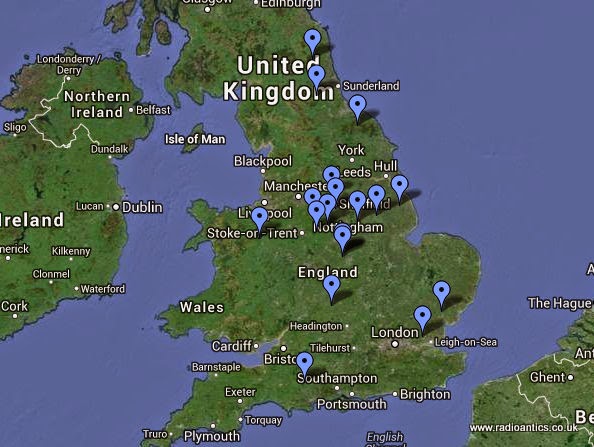Posts Tagged ‘Contest’
 144MHz Backpackers Contest
144MHz Backpackers Contest
The Backpacker (3B) section and the concurrent Practical Wireless 144MHz QRP Contest are limited to just 3W. Normally the FT857 can only be lowered to 5W but by applying a negative voltage to the transceivers ALC line via the accessory socket the transmitters output can be lowered. This method is detailed here it is a simple circuit and I will make one up in due course, I didn't have the parts to make one in time.
Anyway I digress, firstly I had to find a suitable hill top that wasn't too far from home. I wanted somewhere quiet and minimised the risk of any confrontation with societies undesirables. A quick look on the local Ordnance Survey map and I spotted a viewpoint symbol.
 |
| 1:50,000 |
 | |
| 1:25,000 |
| The viewpoint |
| The information plate on the viewpoint |
| battery wedged behind drivers seat |
| Parasol stand and painter's telescopic pole |
| Operating from the passenger seat, FT857 on dashboard |
| Antenna up |
I was initially quite nervous setting up as it turned out the road was actually quite busy and I was getting a lot of quizzical looks from passersby, but once I got going I just ignored them and enjoyed the contest a lot. A number of walkers asked what I was up to and it seemed the viewpoint was a stop off on a MG owner's outing this morning.
I made a reasonable amount of contacts, given most people were operating QRP with some decent distances. I did suffer one brain fade and missed another potential locator square when the other station repeated my report back and I blindly wrote it down and then lost them before I was able to correct it.
At one point I thought I would have to pack up as I was getting huge static crackles and pops which were due I think to some nearby high tension electricity pylons and what appeared to be a gathering storm, there was some brief rain but it quickly dissipated.
Next month I am looking forward to the VHF National Field Day and the 3rd Backpackers Contest as a number of members of the South Kestevan ARS are keen to have a serious attempt.
 Planning some more /P and /A
Planning some more /P and /A
Apart from the UKAC on the Tuesday night I didn't do anything else with the radio, I did have the HF antenna up but the trapped nerve in my back meant I was in a lot of discomfort after being out and about during the day and so rested and zonked out on painkillers rather than struggling to set up the rig.
I must sort out a proper portable station that I can just open it up and start operating, I am impressed with Charlie's M0PZT porta-pack frame idea being an excellent solution especially for back packing.
In the past the wife and I used to be keen walkers, tackling many of the peaks in Cumbria, Snowdonia, the Peak District and elsewhere. We completed the Coast-To-Coast Walk back in 1991 and The Cleveland Way the following year.
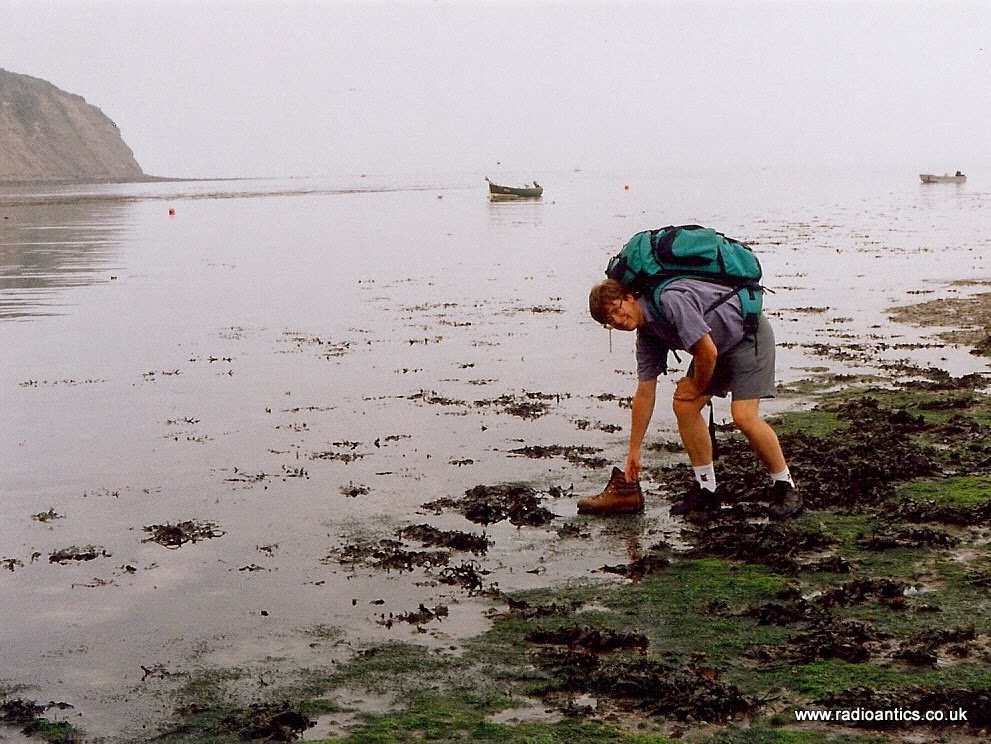 |
| Dipping my boots at Robin Hood's Bay in 1991 at end of the Coast-To-Coast |
Sadly I am too overweight now to be a serious Summits On The Air (SOTA) operator but I plan on getting back to a reasonable level of fitness. As it happens if I'd been more prepared our walk of Latrigg last week could have been my first Wainwright On The Air (WOTA) activation.
Next month we are off to the Isle of Skye. We are staying in a self-catering cottage with plenty of room so rather than being /P portable I can be /A alternative and will be able to set up the rig in the cottage so can use it as and when I want.
I've already mentioned the holiday coincides with the 50MHz/6 Meter UKAC and am currently toying with the antenna choice, one advantage of being so far North is I won't need to rotate it as pointing it South South East should cover most of the UK. From the photographs of seen the cottage is reasonably elevated with clear views across Loch Bay in that direction. There are mountains ranges to contend with but who knows with propagation? I'll be in the rare IO67 locator square so might even have to contend with a pile up!
I will almost certainly operate as 2E0NRD rather than M6GTG for that week as using just 10W might be a bit optimistic.
 |
| IO67 Locator Square |
Gobsmacked.. pic.twitter.com/sGDI4jDh1W
— Andrew Garratt M6GTG (@nerdsville) June 7, 2014
Perhaps I shouldn't have been quite as quick to brag as it appears I was the only Foundation Level entrant!
Still I managed 4 verified QSOs on what by all accounts was a very difficult contest, with low activity and poor conditions. In fact I almost missed the contest altogether and was only alerted to the contest by a tweet by Robert @G1ZJP and was late starting as I needed to get the antenna up. I actually made 5 QSOs but one was broken because I mistakenly put 59 in as the serial number.. Doh!
This weekend is the 2nd RSGB 144MHz Backpackers contest and the Practical Wireless 144MHz QRP Contest Unfortunately the FT857 is too powerful for the QRP contests as the limit is 3W but I could have a go at the Hill Toppers section in the RSGB contest which is limited to 10W and as luck would have it I am left to my own devices this weekend so might take a drive in the car..
 2m UKAC results
2m UKAC results
Last night I went on 2m SSB with 5W in the monthly UKAC activity contest. After 1 hour and 40 minutes I had to stop as my voice was gone (stroke). Best DX missed was GI6ATZ in N.Ireland. I called him a few times without success.
In all 16 QSOs were completed showing that modest power and antenna from the home QTH is enough to enjoy the contest. Had I stayed on longer I’m sure I would have worked more squares. Quite a few stations in northern England worked too on the small, hand rotated, 3el beam, from the home QTH.
Looking at the map, I should have turned the beam towards the SW. Hardly likely I’ll come other than close to the bottom, but that was not the point – it was good fun taking part.
 |
| 2m stations worked with 5w/3el UKAC June 3rd 2014 |
 First time working portable
First time working portable
My new callsign is 2E0NRD
| Current QTH |
I am currently writing this blog entry while on holiday sitting in the caravan watching the sun rise over the Lake District. I have brought the rig along with a M0CVO magitenna for HF and not wanting to miss out on the 144MHz UKAC tonight have a Sandpiper 3-Element Delta Quad.
It has already caused some strange looks on the campsite while I built it up and tested it last night and I hope I won't have any RFI issues as caravans are often fitted with wideband TV amplifiers! Thankfully the site is currently very quiet as the school holidays have finished.
| Testing the Delta Quad last night |
Initially was going to make a Moxon for 2m but I messed up my first attempt and ran out of time to make another so at the last minute ordered the Delta Quad from Sandpiper. It is a well built antenna I just had to cut the three loops and solder them up, the instructions were very clear. It is easily dismantled and seems ideal for portable work so is an investment for the future. I hope to use it during July's VHF NFD.
The antenna has an excellent VSWR match and when testing I clearly heard a cw/jt65 beacon around 144.480MHz which must have been GB3NGI on the Slieve Anorra Mountain in County Antrim, Northern Ireland (IO65VB)
I will be operating as M6GTG/P tonight as don't want to upset my UKAC scores and I am not really sure what to expect as surrounded by mountains in most directions here but should be fun. I might even rope in Boris to give me a hand
| Boris not looking too impressed |
Last Tuesday (27 May) was the 50MHz UKAC. I had intended to do some operating over previous Bank Holiday weekend and with reports of Sporadic E propagation picking up on 6m I had put my homebrew Moxon back up on the pole with the new rotator. Unfortunately the operating was curtailed due to the discomfort I am currently suffering due to a trapped nerve in my back.
That weekend saw some horrendous weather and it rained heavily for several days, indeed it had rained most of Tuesday, checking the VSWR in the evening before the start of the contest I was shocked to see it had risen from 1:1.5 to nearly 1:3!
I knew the bad weather was forecast before putting the antenna up so had made sure all the coax connectors and the feedpoint were properly sealed with self amalgamating tape so was somewhat perplexed. In the end I decided what I thought the issue was, the moxon frame was untreated softwood and in the bad weather had become very wet and damp and suspect it was affecting the resonance.
Despite this I decided to carry on as I was only running 10W and had a productive few hours despite some local noise.
I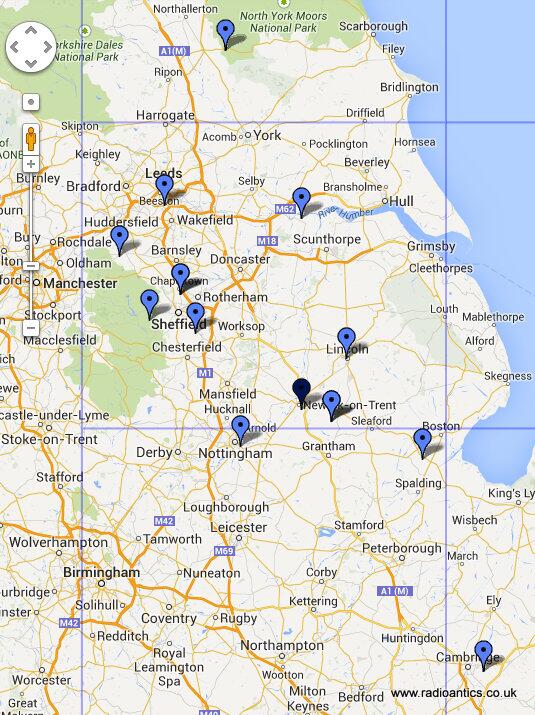 |
| 27 May 2014 - M6GTG 50MHz UKAC QSO Map |
Anyway time to put the kettle on and I will post an update about how I get on tonight.
 LHS Episode #125: YFKTest Lives!
LHS Episode #125: YFKTest Lives!
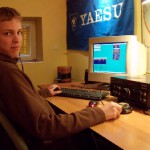 In this episode of Linux in the Ham Shack, Pete goes AWOL. While he’s out being dishonorably discharged, Harrison and Cheryl step in to fill his medium-sized shoes. We also get an interview with Bob, W9YA, current maintainer of YFKTest. He tells us all about the new and exciting world of YFKTest and how it’s not, in fact, dead.
In this episode of Linux in the Ham Shack, Pete goes AWOL. While he’s out being dishonorably discharged, Harrison and Cheryl step in to fill his medium-sized shoes. We also get an interview with Bob, W9YA, current maintainer of YFKTest. He tells us all about the new and exciting world of YFKTest and how it’s not, in fact, dead.
73 de The LHS Guys
 Been a busy boy
Been a busy boy
JT-65HF
I have been using my newly built datamode interface in anger.
As well as running WSPR on occasion I have also been active using JT65-HF.
JT65 is a communication mode developed by Joe Taylor, K1JT, (specification here) originally intended for amateur radio communication with extremely weak signals such as Earth-Moon-Earth (EME) contacts on VHF it has gained popularity on the short wave bands using JT65-HF an adaptation of the JT65A protocol.
Being restricted to 10W it is an attractive method of making contacts. The protocol includes error-correcting features that make it usable even when the signals are too weak to be heard or are being subject to interference.
There are several how-to guides available
Get On the Air with HF Digital (from the ARRL)
JT65-HF -- an 'Odd' but Fun Digital Mode (from eham.net)
A number of software packages support JT65, the most popular being JT65-HF originally developed by Joe, W6CQZ. Sadly Joe is no longer developing the software, but the last version released still works, and is available at http://sourceforge.net/projects/jt65-hf/
Thankfully the project was open source and Beat Oehrli, HB9HQX as developed his own version with the catchy title JT65-HF-HB9HQX-Edition, available at http://sourceforge.net/projects/jt65hfhb9hqxedi/ This is the version I have been using with great success, the colour coding and simple button pressing makes a QSO straight forward and the built in logging and exporting make uploading to QRZ, eQSL and HRDlog painless.
Whilst to a traditionalist amateur operator it is perhaps a little slow, remote and impersonal (each exchange occurs during alternate minutes) I really like it! One advantage is I can set up the radio in the shack with CAT control via HRD and then have QSOs while VNC'ing into the computer from the laptop whilst in front of the TV with the wife and the dogs! (Thanks Tim G4VXE for that suggestion!)
I have been active on the 10/20/30 and 40M bands over the past few weeks making contacts with Bulgaria, Canada, Denmark, Germany, Greece, Iceland, Kazakhstan, Poland, Russia, Serbia, Sweden, Thailand, Ukraine, USA and Venezuela.
Contesting 'DX' Headset and Interface
I have become hooked on the RSGB UKAC VHF contests, operating on a Tuesday evening on different frequencies (50MHz, 144MHz, 432MHz depending on which week of the month) Whilst my results are small-fry compared to the big guns I have been more than happy with my modest antenna set up and less than ideal location (previous blog posts)
I soon appreciated that using headphones rather than the speaker made life easier but I was still using the stock supplied hand microphone. Several times I have found it difficult to make myself understood and suspected that not only am I plagued by my 'Black Country' accent and poor enunciation but maybe the microphone wasn't quite cutting it.
Not able to afford or justify the purchase of a Heil headset just yet I took inspiration from Charlie M0PZT and his recommendation for a budget solution using a £10 computer headset from CPC (product AV21444).
On the Yaesu FT-857D the microphone connector is a 8-pin RJ45 socket which is behind the removable front panel with the lead coming out of one of a number of openings. Whilst the panel is easily removable I didn't want to keep removing it when switching between microphones, also re-purposing an obvious CAT5 network lead was problematic as they are often thicker than the openings.
| The lead removed from MH-31, RJ45 on interface |
| Mic lead connected and headset |
| The budget 'dx' headset |
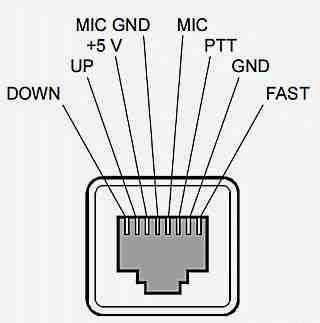 |
| Yaesu FT-857D mic socket as view from front |
The box also has a PTT switch, this could have simply grounded the PTT line but I wanted to have a LED indication on the box and again I could have just wired a LED and resistor to 5V and to the PTT line so it would light when the switch was closed, pulling PTT to ground and completing the circuit. I opted to use a simple transistor open collector switch to add a little isolation.
The interface works well and I used it for the first time last night in the 50MHz UKAC with my homebrew MOXON antenna...
6M/50MHz MOXON
My first contest back in January was the 50MHz UKAC and as I blogged I made a solitary contact due to antenna issues, i.e I didn't really have one!
I missed the February contest so this month I really wanted to have a decent stab at it which meant building an antenna. I decided early on that a Moxon was probably the easiest to construct, so I downloaded the MoxGen program to calculate the element lengths.
Using 1mm diameter 'garden wire' for the driven element and reflector. I had various bits of flexible plastic pipe kicking about and decided to use them to construct an x-shaped spreader, unfortunately the pipe was obviously from different batches and as soon as it was tensioned by the wire it bent into all sorts of strange shapes due to the different elastic properties so I abandoned that design.
I had left the build to the last minute and needed a quick solution, so yesterday morning plan-B was to go an get some cheap timber from the local B&Q on the way to work and build a simple frame to wrap the wire round.
| Moxon on garage floor |
| Coax and common-mode choke, and sturdy support! |
One thing I hadn't appreciated was just how big the final antenna was, it wasn't heavy just big! So last night an hour before the contest started I fitted the choke balun and coax to the terminal block. To be safe I removed the other antenna from the mast and hoisted her up.
| Up in the night sky |
Moment of truth, thankfully the VSWR was around 1.5:1 at 50.2MHz, rising to nearer 2:1 at the top end of the band. Not ideal but close enough. The VSWR measurements would suggest that the Moxon is a little bit long, interestingly some online Moxon calculators suggested dimensions for a slightly smaller Moxon than the downloaded Moxgen program did? Something to tweak/experiment with possibly using some thicker wire to increase the bandwidth.
50MHZ UKAC 25 March 2014
I was sorted! Moxon antenna up, contesting headset and interface plugged in and a quick scan up and down and I could clearly hear several stations testing and setting up. I poured myself a beer and soon the contest started.
| Time between QSOs for a 'selfie' |
I was not disappointed in fact I was quite happy with what my 10W, my new headset and home brewed antenna had achieved. The Moxon showed great promise and directional characteristics but for some reason just couldn't get south as the map indicates.
Out of interest I wondered what the line of slight view from my mast looked like so I strapped a camera on to the moxon this afternoon..
Need more height I think, especially if pointing South and a rotator would be nice!
Well that wraps it up for the moment.. 73
 432MHz UKAC – 11 February 2014
432MHz UKAC – 11 February 2014
I rewired the 7-element ZL-Special on Monday night, and adjusted it to get an excellent VSWR of nearly 1:1 and mounted to the pole.
Setting up last night I raised up the pole around 19:30 and a quick check showed the VSWR was over 1:2!
Yesterday it rained and sleeted very heavily, as suspected the culprit was where I joined two pieces of coax. I had used plugs and a coupler but had run out of self-amalgamating tape to waterproof it, so had resorted to wrapping it in insulating tape... bad idea! Removing the tape it soon became evident that everything was very damp, I quickly dried all the connectors down and gave it a quick blast with a hot air gun. All sorted, the VSWR was back to just over 1:1 (must visit Screwfix for some more tape)
I was much more relaxed for this contest, it was an enjoyable but difficult evening and made just 8 contacts, claiming 762 points. I heard quite a few calls but just couldn't make myself heard. I kept popping out the shack to turn the antenna, listening to other QSOs I was able to use the locator to determine the optimum bearing.
One observation I made was the apparent poor front to back ratio, some calls coming in loudly despite the antenna being in the opposite direction which suggests the phasing isn't quite right.
The map below shows my results.
A night off next Tuesday as it's the 23cm contest, but hoping to be better set up for the following weeks 50MHz contest, hopefully getting better results than I did last time.
View UKAC 432MHz 11-Feb-2014 in a larger map
